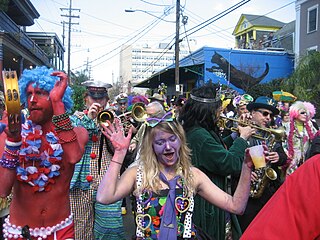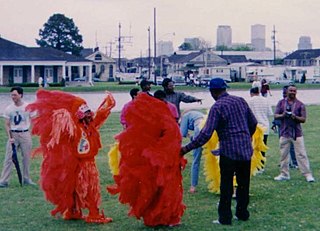
Mardi Gras refers to events of the Carnival celebration, beginning on or after the Christian feasts of the Epiphany and culminating on the day before Ash Wednesday, which is known as Shrove Tuesday. Mardi Gras is French for "Fat Tuesday", reflecting the practice of the last night of eating rich, fatty foods before the ritual Lenten sacrifices and fasting of the Lenten season.

A krewe is a social organization that stages parades and/or balls for the Carnival season. The term is best known for its association with Mardi Gras celebrations in New Orleans, but is also used in other Carnival celebrations throughout South Louisiana and along the Gulf of Mexico, such as the Gasparilla Pirate Festival in Tampa, Florida, Springtime Tallahassee, and Krewe of Amalee in DeLand, Florida with the Mardi Gras on Mainstreet Parade as well as in La Crosse, Wisconsin and at the Saint Paul Winter Carnival.

The Mistick Krewe of Comus, founded in 1856, is the oldest, continuous, New Orleans, Louisiana, Carnival Krewe having paraded with few interruptions from 1856 to 1991, while continuing to hold a tableau ball for its members and guests to date.

Rex is a New Orleans Carnival Krewe which stages one of the city's most celebrated parades on Mardi Gras Day. Rex is Latin for "King", and Rex reigns as "The King of Carnival".

The holiday of Mardi Gras is celebrated in southern Louisiana, including the city of New Orleans. Celebrations are concentrated for about two weeks before and through Shrove Tuesday, the day before Ash Wednesday. Mardi Gras is French for Fat Tuesday, but the season actually begins on King's Day, January 6, and extends until midnight before Ash Wednesday. Club, or Krewe, balls start soon after, though most are extremely private, with their Kings and Queens coming from wealthy old families and their courts consisting of the season's debutantes. Most of the high society Krewes do not stage parades. As Fat Tuesday gets nearer, the parades start in earnest. Usually there is one major parade each day ; many days have several large parades. The largest and most elaborate parades take place the last five days of the Mardi Gras season. In the final week, many events occur throughout New Orleans and surrounding communities, including parades and balls.

Mardi Gras Indians are black carnival revelers in New Orleans, Louisiana, who dress up for Mardi Gras in suits influenced by Native American ceremonial apparel.
The French Quarter neighborhood of New Orleans, Louisiana is the center of the city's Carnival celebrations, especially on Mardi Gras Day. This part of town is crowded with both tourists and locals, with the former more numerous in the Upper Quarter, the latter in the Lower Quarter. There are numerous parties and more than one costume contest. While the large motorized floats of the big parades have been prohibited since the early 1970s from going down the Quarter's narrow streets, numerous small marching krewes, parading jazz bands, and groups of revelers converge here. Some krewes parade in the Quarter after starting earlier in the day in other parts of town.

The Faubourg Marigny is a neighborhood of the city of New Orleans, Louisiana, United States.
The Krewe of OAK is a small neighborhood New Orleans Mardi Gras krewe and parade held in the Carrollton neighborhood of New Orleans, Louisiana. The parade starts and ends on Oak Street, presumably the origin of the name, although members say that OAK stands for "Outrageous And Kinky".

"La Société de Saint Anne" is a New Orleans Mardi Gras marching krewe that parades each Mardi Gras Day. La Société de Saint Anne was founded in 1969 by residents of the French Quarter and nearby Faubourgs who recognized the need for a return to earlier traditions of "walking krewes" which at one time were more prevalent but which had been overshadowed by the development of larger float parades in the early 20th Century. As the float parades grew in scale and number, they were forced to move out of the narrow streets of the French Quarter and onto broader venues uptown and in mid-City. The walking krewes were groups of neighbors from various wards of the city who took to the streets on foot, in celebration of their common love for the City of New Orleans and the food, music, drink, spirituality, and lifestyles that developed there during the 18th, 19th & 20th centuries. La Société de Saint Anne was formed to bring the celebration back down to street level and to revive this old tradition of celebration in the residents' own area. In the ensuing years, as the more bohemian elements of the French Quarter were forced to move further downriver to the Marigny and Bywater neighborhoods by rising property values and rents in the French Quarter, the krewe grew in size and inspired many other such walking krewes to form as subkrewes or as separate krewes altogether. The original krewe now can be identified by the cluster of crabnets and the presence of the Storyville Stompers.

Bywater is a neighborhood of the city of New Orleans. A subdistrict of the Bywater District Area, its boundaries as defined by the City Planning Commission are: Florida Avenue to the north, the Industrial Canal to the east, the Mississippi River to the south, and the railroad tracks along Homer Plessy Way to the west. Bywater is part of the Ninth Ward of New Orleans. It includes part or all of Bywater Historic District, which is listed on the National Register of Historic Places.

In New Orleans, Louisiana, United States, downtown has historically referred to neighborhoods along the Mississippi River, downriver from Canal Street – including the French Quarter, Tremé, Faubourg Marigny, Bywater, the 9th Ward, and other neighborhoods. Contrary to the common usage of the term downtown in other cities, this historic application of the term excluded the New Orleans Central Business District. The term continues to be employed as it has been historically, although many younger people and migrants from other parts of the country will use "downtown" as it is used elsewhere; that is, to mean the Central Business District/Warehouse District area.

Chief Allison "Tootie" Montana, a lather by trade, was a New Orleans cultural icon who acted as the Mardi Gras Indian "Chief of Chiefs" for over 50 years. Tootie is revered in the Mardi Gras Indian culture as the Big Chief. Tootie was the Big Chief of the Yellow Pocahontas Tribe and made the culture of the Mardi Gras Indians about pageantry rather than combat display.
KOE, formally known as the Krewe of Elvis, is a Mardi Gras parading organization that consists of members from around the world who meet in New Orleans for Mardi Gras.

Mardi Gras is the annual Carnival celebration in Mobile, Alabama. It is the oldest official Carnival celebration in the United States, started by Frenchman Nicholas Langlois in 1703 when Mobile was the capital of Louisiana. Although today New Orleans and South Louisiana celebrations are much more widely known for all the current traditions such as masked balls, parades, floats and throws were first created there. From Mobile being the first capital of French Louisiana (1702), the festival began as a French Catholic tradition. Mardi Gras has now evolved into a mainstream multi-week celebration across the spectrum of cultures, becoming school holidays for the final Monday and Tuesday, regardless of religious affiliation.

Jean-Bernard Xavier Philippe de Marigny de Mandeville (1785–1868), known as Bernard de Marigny, was a French-Creole American nobleman, playboy, planter, politician, duelist, writer, horse breeder, land developer, and President of the Louisiana State Senate between 1822 and 1823.

A mystic society is a Mardi Gras social organization in Mobile, Alabama, that presents parades and/or balls for the enjoyment of its members, guests, and the public. The New Orleans Krewe is patterned after Mobile's Mystics. The societies have been based in class, economic and racial groups. Mobile's parading mystic societies build colorful Carnival floats and create costumes around each year's themes.

Mardi Gras in the United States is not observed nationally across the country, largely due to the country's Protestant and Anglo-Saxon roots. Mardi Gras and Carnival are mostly Catholic holidays, while the United States has a Protestant-majority population. However, a number of cities and regions in the U.S. have notable Mardi Gras or Carnival celebrations. Most of these places trace their Mardi Gras celebrations to French, Spanish, and other Catholic colonial influences on the settlements over their history. The earliest Carnival celebration in North America occurred at a place on the west bank of the Mississippi River about 60 miles (97 km) downriver from where New Orleans is today; this Mardi Gras on March 3, 1699, and in honor of this holiday, Pierre Le Moyne, Sieur d'Iberville, a 38-year-old French Canadian, named the spot Point du Mardi Gras near Fort Jackson. The earliest organized Carnival celebrations occurred in Mobile, then the capitol of French Louisiana known as Fort Louis de la Mobile, where in 1704 the first known Carnival secret society. In 1856, six Mobile natives established the first secret society, or krewe, in New Orleans, the Mistick Krewe of Comus. Former French and Spanish colonies such as Pensacola, Biloxi, and settlements along the Gulf Coast all followed suit in incorporating Carnival into their annual celebrations, which today have developed either separate traditions or variations of them from one another. In addition, modern activities generally vary from city to city across the U.S.

The 'Irish Channel Corner Club is the second oldest marching club in New Orleans, La. organized in 1918. It is an all-male carnival organization that marches in parades during Mardi Gras, in which they don colorful custom carnival costumes and specifically design Corner Club beads, and St. Patrick's Day, in which they wear their traditional green vests. Their members walk with canes that have colorful flowers that are given away for kisses while they dance and drink in the streets.
Henri Schindler is a New Orleans Mardi Gras historian and float designer.





















